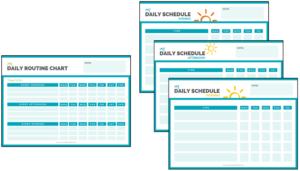
Surviving Online Learning: A Guide for Parents (Plus, Homeschool Schedule Printables)
With schools around the country closing their doors, you might be worried about how your child will manage online learning. This is a huge change for many kids and families, and children with ADHD may struggle with this new transition. Shifting to an online school model can present new challenges for kids, including difficulty separating “home” time from “school” time.
Here at Next Step 4 ADHD, we are proud to offer support and tips to help you and your family, especially during this time of social isolation.
Keri Knight, LCSW has curated a list of several tips to help parents survive online learning with their children, so children with ADHD can adjust to online learning and thrive during this time.
6 Steps to Make Online Learning Easier
Whether you’re currently working at home or taking a break, shifting to online learning is still a big change. Thankfully, with a little planning, you can survive e-learning with your kids.
1. Name Your Expectations
First, make sure you know what is expected of your child each day. Then, make sure your child knows what the expectations are.
Teachers (and schools in general) have certain expectations for students as far as taking attendance by a certain time each day or establishing deadlines to turn in assignments, etc. Parents should make sure that they understand what is required of the child, especially for younger kids, and then make sure the child understands what is expected of him/her. This ensures that everyone is on the same page.
Things to consider:
- Can she sleep in as late as she wants?
- Will you check in with the teacher or will your child need to do that?
- What if siblings need to share the one computer? How will they work this out based on the requirements of the school/teacher?
- How long is your child expected to sit during “school time”? Expect that staying focused and not getting distracted while doing schoolwork from home is going to be difficult. Managing expectations can help parents not feel frustrated when things don’t go how they want them to.
- What time does your school start?
You can think of this step as creating your own “school rules.” Post your rules where everyone can see them.
2. Reach Out to Your Child’s Teacher
Communicate frequently with your child’s teacher. Don’t be afraid to reach out and ask questions. In fact, asking questions may help you overcome any obstacles quicker. Remember, this is new to teachers too so they will be happy to help you out.
3. Create a Structure
Think of a structure as a daily schedule. Whereas step 1 focused on school rules, step 3 focuses on a schedule.
If your child doesn’t have a specific schedule (from his or her teacher) to follow each day, it will be important that you create one and do your best to stick to it. We created a printable schedule to help you get started. Download the bundle here.
Tip: When creating a schedule for a child with ADHD, remember that every kid is different so their needs will be different as well.
- Include breaks in your schedule. Some children with ADHD may need more frequent breaks to move around so they can focus.
- Work in the afternoon if needed. Some children are night-owls and are more productive later in the evening than in the morning.
- Don’t neglect your morning routine. Many children may struggle to wake up and get out of bed on time. Their schedule may need to include a morning routine with lots of time to transition from sleeping to waking and then into schoolwork.
- Consider accommodations. If your child receives accommodations at school, these may need to be replicated at home. For example, if your child receives extra time on assignments at school, you may need to add extra time into the schedule for your child to complete assignments at home too.
- Include your children in the process. Have your child help you by offering suggestions. Giving your child a say will increase his or her buy-in, and they’ll be more likely to cooperate.
- Be specific. Children with ADHD do well with structures. For independent reading time, don’t write “read a book” on the schedule. Instead, break it down. Allot 3 minutes to choose a book, 2 minutes to get into the designated reading area, and 20 minutes for the actual reading.
4. Create the Right Environment
Your child’s school environment is important.
- Find or create a workspace that is conducive to working. Workspaces can include the dining room table, the kitchen counter (if you have an island or counter with seating), a desk in the living room, a lap desk on the couch, etc. Avoid working in a playroom or bedroom (if that’s where all of your child’s toys are). Seeing the toys can be visually distracting for your child.
- Eliminate distractions and clear any clutter. If your child is working on the table or counter, remove anything unrelated to school during school hours.
- Stay consistent. Having one place where they go to work each time can help increase their focus and trains their brain to know that when they’re sitting at their spot then it’s time to work.
Not being in a classroom setting can make it more difficult to focus and easier to get distracted. You may need to make things external, concrete, and tangible. For example, you could print out readings, try to use a physical textbook if possible (versus an e-book), write out their daily assignments on a checklist and post it on the wall for them to see.
5. Don’t Forget to Schedule Breaks
Work in regular breaks and move around after completing an assignment. Not only is this good for the body, it’s good for the brain too!
How many breaks you need to schedule will be vary. Every kid is different. You can even ask your child to guess how long they think they can sit down to complete an assignment. If they think they can sit for 20 minutes, then set a timer for 15 (just under what they think they can do). When the timer goes off, take a quick break (get a drink of water, go to the bathroom, etc.) and then come back and set the timer to work for another 15 minutes.
Another strategy is to take shorter, 2-minute breaks. During these mini breaks, have your child run in place, do jumping jacks or push-ups, or run outside to the mailbox and back. This gets the oxygen flowing and can help the brain to focus and can help with restlessness.
6. Establish a System
Once you have your rules and schedule established, you’ll need to create a system. A system ties everything together into one streamlined process. Each family’s system will look different, and that’s okay!
Systems can include:
- Making lists
- Creating folders for each subject on the computer (and storing all website links in each bookmarked folder on your computer)
- Using timers or other extra reminders to turn in assignments
- Using visible reminders with Post-It notes
Download Our Free Tools and Resources: Checklist + Schedule Bundle
As you embark on your online journey with your kids, don’t forget to download our Home School Schedule Template Packet.
What’s in the bundle?
Included in the Home School Schedule Template bundle are printable checklists and schedules.
Daily Routines and Schedules
Checklist and To-Dos
Questions? We’re Just a Call or Click Away
At NextStep 4 ADHD, we’re happy to provide comprehensive care for ADHD — for you and your children. If your child has ADHD, we are happy to help YOU get the resources and education you need to make the your child’s school environment a successful one. Whether you’re interested in online 1:1 coaching, therapy for your child, or other services, we are here to guide you with your next steps. Give us a call or send us a message to request more information.
Don’t forget to sign up for a membership so you can stay up-to-date with the latest news!
Related Posts
Focus Music? Here Are 5 Spotify Playlists to Promote Focus
Last November, we wrote about the benefits of music and how classical music can...
Planning for Christmas with ADHD? Tips for Success
Organizing and planning can be challenging tasks for adults with ADHD — and...



